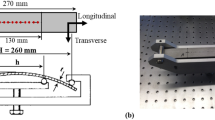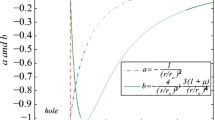Abstract
Background
Optical measurement techniques such as digital image correlation and speckle interferometry have been applied to hole-drilling evaluations of residual stress for some decades. These full-field non-contact measurements can have significant advantages over the traditional strain gauge method. However, optical measurements are still only rarely used for practical measurements outside the research environment. A significant barrier to such use is the mathematical challenge of analyzing the large quantity of optical data to evaluate the residual stresses.
Objective
The objective here is to provide a residual stress computation scheme that can be implemented straightforwardly and efficiently, also to provide the needed calibration data.
Method
The approach taken is to recast the optical data into a compact arrangement that parallels the established format used for strain gauge style calculations.
Results
Several computation variants are explored, some show high stress sensitivity, while others give resistance to common measurement artifacts. Surface displacement data taken from near the hole edge give the highest stress sensitivity, while more distant data give greater ability to identify interior stresses.
Conclusions
The proposed residual stress computation method is shown to be an effective and practical way to compute residual stresses from optical hole-drilling measurements.








Similar content being viewed by others
References
Schajer GS, Whitehead PS (2018) Hole-Drilling Method for Measuring Residual Stress. Morgan & Claypool, Williston, VT, USA.
Grant PV, Lord JD, Whitehead PS (2002) The Measurement of Residual Stresses by the Incremental Hole Drilling Technique. Measurement Good Practice Guide No.53, National Physical Laboratory, Teddington, UK.
Vishay Measurements Group, Inc. (1993) Measurement of Residual Stresses by the Hole-Drilling Strain-Gage Method. Tech Note TN-503–6. Vishay Measurements Group, Inc., Raleigh, NC. 16pp.
Mathar J (1934) Determination of Initial Stresses by Measuring the Deformation Around Drilled Holes. Trans Am Soc Mech Eng 56(4):249–254
Soete W, Vancrombrugge R (1950) An Industrial Method for the Determination of Residual Stresses. Proceedings SESA 8(1):17–28
Boiten RG, ten Cate W (1952) A Routine Method for the Measurement of Residual Stresses in Plates. Appl Sci Res A3(5):317–343
Kelsey RA (1956) Measuring Non-Uniform Residual Stresses by the Hole Drilling Method. Proceedings SESA 14(1):181–194
Rendler NJ, Vigness I (1966) Hole-drilling Strain-gage Method of Measuring Residual Stresses. Exp Mech 6(12):577–586
ASTM (2020) Determining Residual Stresses by the Hole-Drilling Strain-Gage Method. Standard Test Method E837–20. American Society for Testing and Materials, West Conshohocken, PA.
Nelson DV, McCrickerd JT (1986) Residual-stress Determination Through Combined Use of Holographic Interferometry and Blind-Hole Drilling. Exp Mech 26(4):371–378
Steinzig M, Ponslet E (2003) Residual Stress Measurement Using the Hole Drilling Method and Laser Speckle Interferometry: Part I. Exp Tech 27(3):43–46
Schajer GS, Rickert TJ (2011) Incremental Computation Technique for Residual Stress Calculations Using the Integral Method. Exp Mech 51(7):1217–1222
Suterio R, Albertazzi A, Amaral FK (2006) Residual Stress Measurement Using Indentation and a Radial Electronic Speckle Pattern Interferometer - Recent Progress. J Strain Anal Eng Des 41(7):517–524
Stresstech Oy, Finland (2021) Prism Hole Drilling System for Residual Stress Measurement. https://www.stresstech.com/products/prism/ . Accessed 26 Feb 2021.
McGinnis MJ, Pessiki S, Turker H (2005) Application of Three-dimensional Digital Image Correlation to the Core-drilling Method. Exp Mech 45(4):359–367
Focht G, Schiffner K (2003) Determination of Residual Stresses by an Optical Correlative Hole-drilling Method. Exp Mech 43(1):97–104
Nelson DV, Makino A, Schmidt T (2006) Residual Stress Determination Using Hole Drilling and 3D Image Correlation. Exp Mech 46(1):31–38
Schajer GS, Winiarski B, Withers PJ (2013) Hole-Drilling Residual Stress Measurement With Artifact Correction Using Full-Field DIC. Exp Mech 53(2):255–265
Albertazzi A, Zanini F, Viotti M, Veiga C (2015) Residual Stresses Measurement by the Hole-Drilling Technique and DSPI Using the Integral Method with Displacement Coefficients. Proceedings of the 5th International Symposium on Experimental Mechanics and 9th Symposium on Optics in Industry (ISEM-SOI), Guanajuato, Mexico.
Melamed S (2015) Compact ESPI Device for Isotropic Measurements of Residual Stress. M.A.Sc. dissertation, University of British Columbia, Vancouver, Canada.
Boresi AP, Schmidt RJ, Sidebottam OM (1993) Advanced Mechanics of Materials. Wiley, New York
Nau A, von Mirbach D, Scholtes B (2013) Improved Calibration Coefficients for the Hole-Drilling Method Considering the Influence of the Poisson Ratio. Exp Mech 53(8):1371–1381
Schajer GS, Steinzig M (2005) Full-Field Calculation of Hole Drilling Residual Stresses from ESPI Data. Exp Mech 45(6):526–532
An Y, Schajer GS (2011) Pixel Quality Evaluation and Correction Procedures in Electronic Speckle Pattern Interferometry. Exp Tech 35(5):23–29
Schajer GS (1988) Measurement of Non-Uniform Residual Stresses Using the Hole-Drilling Method. Part I. Journal of Engineering Materials and Technology 110(4):338–343.
Schajer GS (1988) Measurement of Non-Uniform Residual Stresses Using the Hole-Drilling Method. Part II. Journal of Engineering Materials and Technology 110(4):344–349.
Schajer GS, Prime MB (2006) Use of Inverse Solutions for Residual Stress Measurements. J Eng Mater Technol 128(3):375–382
Schajer GS (2020) Compact Calibration Data for Hole-Drilling Residual Stress Measurements in Finite-Thickness Specimens. Exp Mech 60(5):665–678
Acknowledgements
This work was financially supported through a grant from the Natural Sciences and Engineering Research Council of Canada (NSERC). Dr. Juuso Heikkinen kindly reviewed the manuscript and made several helpful comments and suggestions.
Author information
Authors and Affiliations
Corresponding author
Ethics declarations
Conflict of Interest
The author declares that he has no conflict of interest.
Additional information
Publisher's Note
Springer Nature remains neutral with regard to jurisdictional claims in published maps and institutional affiliations.
Appendix
Appendix
Rights and permissions
About this article
Cite this article
Schajer, G.S. Optical Hole-Drilling Residual Stress Calculations Using Strain Gauge Formalism. Exp Mech 61, 1369–1380 (2021). https://doi.org/10.1007/s11340-021-00740-7
Received:
Accepted:
Published:
Issue Date:
DOI: https://doi.org/10.1007/s11340-021-00740-7




